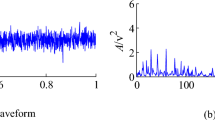Abstract
A new noise reduction method for nonlinear signal based on maximum variance unfolding (MVU) is proposed. The noisy signal is firstly embedded into a high-dimensional phase space based on phase space reconstruction theory, and then the manifold learning algorithm MVU is used to perform nonlinear dimensionality reduction on the data of phase space in order to separate low-dimensional manifold representing the attractor from noise subspace. Finally, the noise-reduced signal is obtained through reconstructing the low-dimensional manifold. The simulation results of Lorenz system show that the proposed MVU-based noise reduction method outperforms the KPCA-based method and has the advantages of simple parameter estimation and low parameter sensitivity. The proposed method is applied to fault detection of a vibration signal from rotor-stator of aero engine with slight rubbing fault. The denoised results show that the slight rubbing features overwhelmed by noise can be effectively extracted by the proposed noise reduction method.
Similar content being viewed by others
References
Hegger R, Kantz H, Matassini L. Noise reduction for human speech signals by local projections in embedding spaces. Circ Syst I: Fund Theory Appl, 2001, 48: 1454–1461
Shin K, Hammond J K, White P R. Iterative SVD method for noise reduction of low dimensional chaotic time series. Mech Syst Sig Proc, 1999, 13: 115–124
Mika S, Schölkopf B, Smola A, et al. Kernel PCA and denoising in feature spaces. Adv Neural Inf Proc Syst, NIPS11, 2000. 11
Gruber P, Stadlthanner K, Böhm M, et al. Denoising using local projective subspace methods. Neurocomput, 2006, 69: 1485–1501
Tenenbaum J B, Silva V D, Langford J C. A global geometric framework for nonlinear dimensionality reduction. Science, 2000, 290: 2319–2323
Roweis S T, Saul L K. Nonlinear dimensionality reduction by locally linear embedding. Science, 2000, 290: 2323–2326
Belkin M, Niyogi P. Laplacian eigenmaps for dimensionality reduction and data representation. Neural Comp, 2003, 15: 1373–1396
Weinberger K, Saul L. Unsupervised learning of image manifolds by semidefinite programming. Int J Comp Vision, 2006, 70: 11–90
Sturm J F. Using sedumi 1.02, a matlab toolbox for optimization over symmetric cones. Optim Method Softw, 1999, 11: 625–653
Borchers B. Csdp: A C library for semidefinite programming. Optim Method Softw, 1999, 11: 613–623
Kostelich E J, Thomas S. Noise reduction in chaotic time series data: A survey of common methods. Phys Rev E, 1993, 48: 1752–1763
Fan J, Gijbels I. Local Polynomial Modeling and its Applications. London: Chapman and Hall, 1996. 84–87
Lee J M, Yoo C K, Choi S W, et al. Nonlinear process monitoring using kernel principal component analysis. Chem Eng Sci, 2004, 59: 223–234
Author information
Authors and Affiliations
Corresponding author
Rights and permissions
About this article
Cite this article
Zhang, Y., Li, B. Noise reduction method for nonlinear signal based on maximum variance unfolding and its application to fault diagnosis. Sci. China Technol. Sci. 53, 2122–2128 (2010). https://doi.org/10.1007/s11431-009-3172-8
Received:
Accepted:
Published:
Issue Date:
DOI: https://doi.org/10.1007/s11431-009-3172-8




